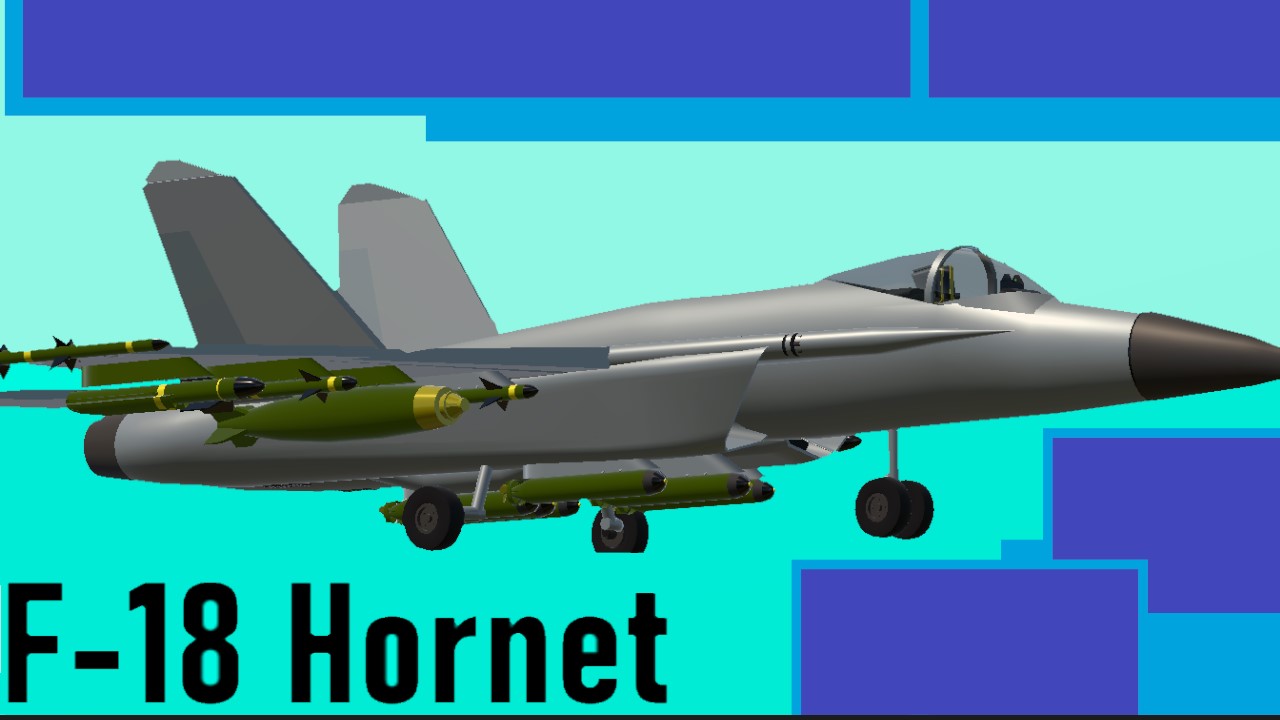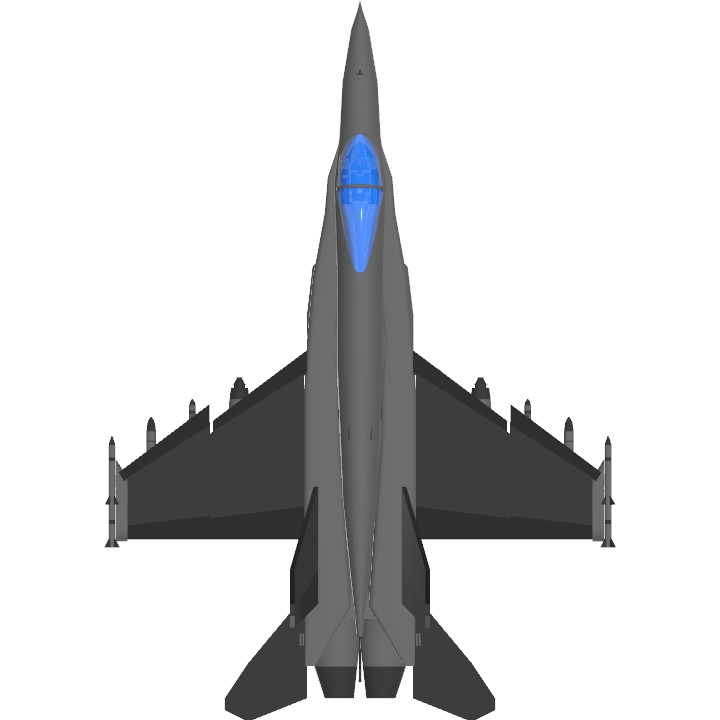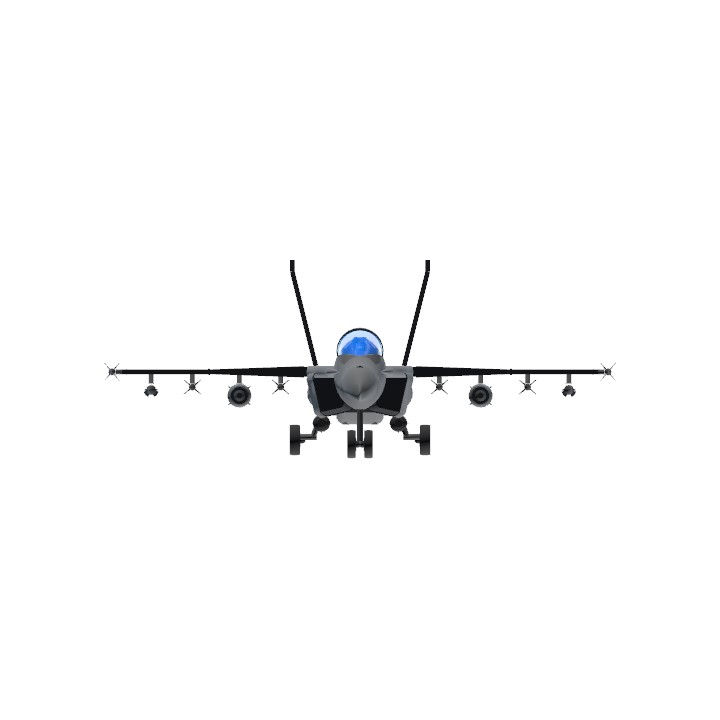Jump To Down
E
The F/A-18 Hornet

The McDonnell Douglas F/A-18 Hornet is a twin -engine , supersonic , all-weather , multirole jet fighter with carrier capability . [ 2 ] Initially developed by McDonnell Douglas , the F/A-18 Hornet is currently produced by Boeing . The F/A-18 Hornet is a derivative of the 1970s YF-17 used by the United States Navy and United States Marine Corps . The Hornet is also used by the air forces of several nations and, since 1986, by the United States Navy's Blue Angels Flight Demonstration Squadron .
The F/A-18 has a maximum speed of Mach 1.8 or 1,915 km/h (40,000 ft) and can carry a wide variety of bombs and missiles, including a 20mm M61 cannon . Vulcan . It is powered by two General Electric F404 turbofan engines , which gives the aircraft a high thrust-to-weight ratio . The F/A-18 has excellent aerodynamic characteristics, attributed to its wingtip extensions .
The primary roles of the F/A-18 are escort, fleet air defense, suppression of enemy air defenses, air interdiction, close air support, and aerial reconnaissance . Its versatility and reliability have proven the fighter to be a valuable carrier-based aircraft, although it has been criticized for lacking range and payload compared to its predecessors, such as the Grumman F-14 Tomcat in the fighter and strike fighter roles and the Grumman A-6 Intruder and LTV A-7 Corsair II in the strike roles.
The Hornet first saw combat during the 1986 US bombing of Libya and subsequently participated in the 1991 Gulf War and the 2003 Iraq War . The F/A-18 Hornet served as the basis for the Boeing F/A-18E/F Super Hornet , its evolved version.
Origin

The U.S. Navy began the Naval-Fighter Attack, Experimental (VFAX) program to provide a multipurpose aircraft to replace the A-4 Skyhawk , A-7 Corsair , and remaining F-4 Phantoms , as well as to complement the F-14 Tomcat . Vice Admiral Kent Lee, then head of Naval Air Systems Command (NAVAIR), was the chief advocate of the VFAX program against strong opposition from several Navy officers, including Vice Admiral William D. Houser, the deputy chief of naval operations for air warfare —the highest-ranking naval aviator in the military. [ 2 ]
In August 1973, Congress issued a mandate for the Navy to seek a cheaper alternative to the F-14; Grumman proposed a stripped-down F-14 designated the F-14X, while McDonnell Douglas proposed a naval variant of the F-15, but both were as expensive as the F-14. That summer, Secretary of Defense James R. Schlesinger ordered the Navy to evaluate competitors for the Lightweight Fighter (LWF) program, the General Dynamics F-16 and the Northrop YF-17 . The Air Force competition specified a day fighter without strike capabilities. In May 1974, the House Armed Services Committee redirected $34 million from the VFAX program to a new program, the Navy Air Combat Fighter (NACF), [ 3 ] which was intended to make maximum use of technology for the LWF program. [ 4 ]
Redesigning the YF-17

Although the F-16 won the LWF program, the US Navy was skeptical that a single-engine aircraft with a narrow landing gear could be economically viable or easily adaptable for carrier operations , and declined to adopt a possible naval variant of the F-16. On 2 May 1975, the US Navy announced the selection of the YF-17. [ 5 ] Since the LWF did not share any of the VFAX requirements, the US Navy asked McDonnell-Douglas and Northrop to develop a new aircraft based on the YF-17 design. On 1 March 1977, Secretary of the Navy W. Graham Claytor announced the designation F-18 and its name: Hornet . [ 4 ]
Northrop partnered with McDonnell-Douglas as the second contractor on the project to capitalize on McDonnell-Douglas's expertise in shipborne aircraft production. For the F-18, the two firms agreed to share construction of the components, with McDonnell-Douglas responsible for final assembly of the aircraft. McDonnell-Douglas would build the wings, horizontal stabilizers, and forward fuselage, with Northrop building the center and aft fuselage sections and vertical stabilizers. McDonnell-Douglas would be responsible for selling the naval version to the U.S. Navy, while Northrop would develop and sell the F-18L, a land-based version of the F-18, for export. [ 4 ] [ 3 ]
The F-18, initially designated the McDonnell-Douglas Model 267, was a drastically modified variant of the YF-17. For carrier operations , the landing gear and arrestor hook were strengthened; folding wings and provision for catapult launch were installed, and the landing gear was widened. [ 4 ]
The Hornets first saw action in 1986, carrying out ground attacks and destroying air defenses in Libya, in support of the A-6E Intruder and A-7 Corsair II ; in 1991, during Operation Desert Storm , the Hornets, both carrier-based and Marine- based, flew a large number of strike and close air support missions. On January 17, a pair of F/A-18Cs from the USS Carl Vinson , escorted by two F-14D Tomcats , were en route to attack H-2 Air Base in western Iraq, when a group of USAF F-15Cs called in the Tomcats to deal with four MiG-25PDs, leaving the F/A-18s alone. Five minutes later, an E-3 sentry alert aircraft alerted the Hornets that two J-7s (a Chinese version of the MiG-21 Fishbed) had appeared just 10 km away. The Hornets immediately switched their radar from air-to-ground to air-to-air mode, and in quick succession, shot down the J-7s using the AIM-7E3 Sparrow and the AIM-9M Sidewinder . They then switched back to air-to-ground mode and completed the attack on H-2, which was very successful. That same morning, an F/A-18C was shot down by a MiG-25PD, using the R-40 missile. At first, the US Navy even confirmed the downing, but soon after denied it, saying that the aircraft was shot down by anti-aircraft defenses (it was later found that the closest battery to the site of the downing was about 45 km away).
Features


Capable of carrying a wide range of weapons, the F-18 soon became the US Navy 's primary fighter. While the F-14 provided long-range interception, the Hornet had the versatility of short-range interception, defense, sea-to-land attack and reconnaissance. Its excellent maneuverability earned the F/A 18 the reputation of one of the best close-range dogfight fighters .
Its main armaments are the AIM-120 AMRAAM medium-range fire-forget air-to-air missile, the AIM-9 Sidewinder short-range thermal-guided missile , the AGM-65 Maverick air-to-ground missile used primarily against armored ground vehicles, and its accurate (positioned just above its nose) 20 mm Vulcan cannon.
Functions of a super fighter
Currently, to be elected an air/technological superiority fighter, it is not enough to just have great maneuverability and other close-range combat capabilities, but rather to be a multi-task fighter, capable of acting and supporting the wide range of requirements that the unpredictable environment of a conflict brings.
Other functions of the Super-Hornet include:
Day/night attacks with high precision weapons
Electronic warfare system
Armed escort
Short-range air support
Oppression of enemy air defense
Sea Attack
Recognition
Air traffic control leadership
Refueling plane
Air control
Flexibility
The Super-Hornet's versatility also applies to its weapons and payload:
11 hangers (weapon/equipment support stations)
Support for smart weapons, including laser-guided bombs
Can carry a range of weapons, both air-to-air and air-to-surface
Power and flight characteristics
The Super Hornet is powered by two GE F414-GE-400 engines.
Variable circumference engines that reduce radar signature and provide greater air/pressure control in the turbine
9,080 kg thrust per engine
Equipment and technology
The F/A-18 has more current variables with a great increase in performance both as a machine and as a computer. Its targeting systems include the advanced Joint-helmet mounted cueing system (JHMCS), a targeting system from the pilot's visor, where it is only necessary to position the pilot's head in the direction of the target, so that the smart bombs detect and aim at the target. Radar with active electronically scanned array (AESA) among other large, versatile and compatible control and targeting systems.
Operations
The Hornets first saw action in 1986, carrying out ground attacks and destroying air defenses in Libya, in support of the A-6E Intruder and A-7 Corsair II ; in 1991, during Operation Desert Storm , the Hornets, both carrier-based and Marine- based, flew a large number of strike and close air support missions. On January 17, a pair of F/A-18Cs from the USS Carl Vinson , escorted by two F-14D Tomcats , were en route to attack H-2 Air Base in western Iraq, when a group of USAF F-15Cs called in the Tomcats to deal with
four MiG-25PDs, leaving the F/A-18s alone. Five minutes later, an E-3 sentry alert aircraft alerted the Hornets that two J-7s (a Chinese version of the MiG-21 Fishbed) had appeared just 10 km away. The Hornets immediately switched their radar from air-to-ground to air-to-air mode, and in quick succession, shot down the J-7s using the AIM-7E3 Sparrow and the AIM-9M Sidewinder . They then switched back to air-to-ground mode and completed the attack on H-2, which was very successful. That same morning, an F/A-18C was shot down by a MiG-25PD, using the R-40 missile. At first, the US Navy even confirmed the downing, but soon after denied it, saying that the aircraft was shot down by anti-aircraft defenses (it was later found that the closest battery to the site of the downing was about 45 km away).
Specifications (F/A-18C/D)
Data from: US Navy , [ note 1 ] Frawley Directory , [ note 2 ] Great Book . [ note 3 ]
General descriptions
Crew : F/A-18C: 1, F/A-18D: 2
Length : 17.1 m (56 ft )
Wingspan : 12.3 m (40 ft )
Height : 4.7 m (15 ft )
Wing area : 38 m² (409 ft² )
Empty weight : 10 400 kg (22 900 lb )
Gross weight (laden): 16 770 kg (37 000 lb )
Takeoff weight: 23 500 kg (51 800 lb )
Fuel capacity: 4 930 kg (10 900 lb ) of internal fuel
Motorization
Number of engines: 2x
Engine type : Turbofan
Manufacturer/Model: General Electric F404 -GE-402
Thrust per engine : 8,052 kgf (17,800 lbf ) (79.2 kN )
Performance
Top speed : 1,915 km/h (1,190 mph )
Total speed at Mach : 1.8 Ma
Range : 3,330 km (2,070 mi )
Military range: 740 km (460 mi )
Rate of climb: 254 m/s
Service ceiling : 15 240 m (50 000 ft )
Armaments
Machine guns / cannons : 1x 20 mm (0.79 in ) M61 Vulcan cannon
Number of pylons: 9x
Pylon capacity (kg): 6 200 kg (13 700 lb )
Pylon bombs: B61 nuclear
JDAM
Paveway Series
Mk 80 Series
CBU-87
CBU-89 GATOR
CBU-97
Mk-20 Rockeye II
Pylon rockets: 70 mm (2.8 in ) Hydra 70
Zuni 127 mm (5.0 in )
Pylon missiles:
Air-to-air missiles
4× AIM-9 Sidewinder or 4× AIM-132 ASRAAM or 4× IRIS-T or 4× AIM-120 AMRAAM and
2× AIM-7 Sparrow or 2× AIM-120 AMRAAM
Air-to-surface missile
AGM-65 Maverick
AGM-84H/K Standoff Land Attack Missile Expanded Range (SLAM-ER)
AGM-88 HARM Anti-radiation missile (ARM)
AGM-154 Joint Standoff Weapon (JSOW)
AGM-158 Joint Air-to-Surface Standoff Missile (JASSM)
Taurus (Cruise Missile)
Anti-ship missile
AGM-84 Harpoon
Other pylon charges:
Electronic countermeasures:
SUU-42A/A
ECM Pod
AN/AAS-38
LITENING
Up to 3x 330 US-gal (1,250 l ) tanks
Guidance equipment
Avionics :
Radar:
Hughes APG-73
Others:
Remotely Operated Video Enhanced Receiver (ROVER)
Operators
Australia
Canada
Spain
United States
Finland
Kuwait
Malaysia
Switzerland
Specifications
Spotlights
- This craft is curated
General Characteristics
- Created On Windows
- Wingspan 35.1ft (10.7m)
- Length 50.2ft (15.3m)
- Height 13.7ft (4.2m)
- Empty Weight 21,107lbs (9,573kg)
- Loaded Weight 41,639lbs (18,887kg)
Performance
- Power/Weight Ratio 1.619
- Wing Loading 111.4lbs/ft2 (543.8kg/m2)
- Wing Area 373.8ft2 (34.7m2)
- Drag Points 5322
Parts
- Number of Parts 193
- Control Surfaces 10
- Performance Cost 1,320






J U M P T O D O W NHORNET
@MrCOPTY ok
Gun Emplacement isn't accurate bud💀